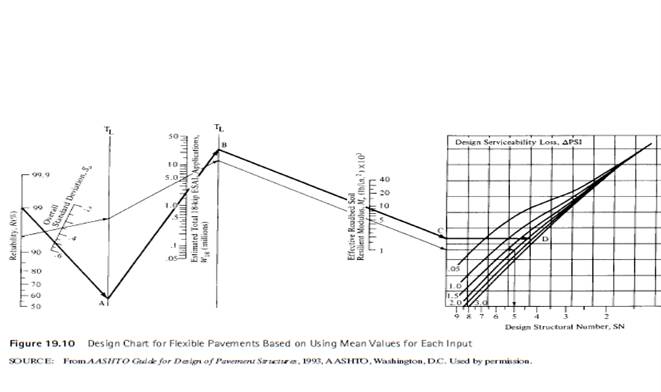
Concept explainers
Repeat Problem 19-7 using two different depths of untreated aggregate bases of 6 in. and 12 in. Highway contractors in your area can furnish rates for providing and properly laying an asphalt concrete surface and untreated granular base. Assume a structural coefficient of 0.12 for the base course. If these rates are available, determine the cost for constructing the different pavement designs if the highway section is 5 miles long and the lane width is 12 ft. Which design will you select for construction?
The cost for constructing the different pavement designs.
Answer to Problem 13P
Explanation of Solution
Given information:
Following is the given information:
Equivalent single axle load, ESAL =
CBR =
Subgrade resilient modulus =
Sub-base layer coefficient =
Granular base layer coefficient =
Elastic modulus of asphalt concrete =
mi = 1, Percentage of traffic on design lane =
SN = 4, reliability level =
and design serviceability loss =
Calculation:
We have the following formula for the calculation of truck factor:
Where, ESAL i= equivalent accumulated 18,000-lb (80-kN) single-axle load for the axle category i
fd= design lane factor,
G rn= growth factor for a given growth rate r and design period n
AADT i= first-year annual average daily traffic for axle category i
N i= number of axles on each vehicle in category i
F Ei= load equivalency factor for axle category i
Calculate ESAL for passenger car
We have the following formula for the calculation of design serviceability :
Substitute the values in the required equation.
Initial serviceability index,
Terminal serviceability index,
Let's determine the resilient modulus of subgrade:
The resilient modulus of subgrade is 1500 times CBR
The value of resilient modulus is given as follows:
Now for the structural number, SN refer to figure 19.10
The reliability level is 90%. Starting from the point 90% in figure, extend this point to standard deviation 0.45. From standard deviation point, extend this line to line A as given in the figure.
From line A extend this line to
From ESAL extend this line to line B in the figure.
From line B extend this line to
From M rextend this line till it touches the graph. From that point, draw a horizontal line to touch the design serviceability loss, which is 2.
Extend a line vertically and take the structural number SN3reading, which is 2.5 and SN2is 2.3
Then from figure 19.6, for layer coefficient and the resilient modulus for base layer is
From figure 19.10, resilient modulus is
Refer figure 19.7 to determine layer coefficient

Now, considering the thickness aggregate base as 6 inches.
Calculate the minimum thickness.
The layer coefficient,
Substitute the values
Checking the values, we have
As the values match, thus the thickness of subgrade calculated is correct.
Calculate the required minimum thickness of base course D2is 6 inches.
Check whether the calculated thickness agrees with the calculated structural number using equation
Substituting the values, we have
Which is compatible with the structural number calculated already.
And implies that the thickness of the surface calculated is correct.
Now, the required minimum thickness of the sub-base course
By substituting the values, we have
Now, check if the calculated thickness agrees with the calculated structural number of using the following equation:
Substituting the values
Which is compatible with the structural number calculated already.
And implies that the thickness of the surface calculated is correct.
The thickness of surface 4.25 inches.
Now, considering the thickness aggregate base as 12 inches.
Calculate the minimum thickness.
Substitute the values, we have
Thus, the thickness of sub grade is 1.7 in.
Now, the thickness of the base course is given as follows:
Substitute the values.
Which is greater than 2.7, i.e., structural number.
Now, the required minimum thickness of the sub-base course
By substituting the values,
Now, check if the calculated thickness agrees with the calculated structural number of using the following equation
Substituting the values,
Which is compatible with the structural number calculated already.
And implies that the thickness of the surface calculated is correct.
Calculate construction cost for the highway considering thickness of base layer as 6 inches and 12 inches.
The cost is calculated by multiplying the measurement of road with the cost per rate.
Assume cost of surface layer as
For cost of base layer
For cost of sub-base layer
The construction cost of the highway is as follows:
Cost = L X B X t X C
For surface layer :
Substitute the values
5 miles is equal to 26400
For base layer :
Substitute the values
For sub-base layer :
Substitute the values
Now, calculate the total cost as follows:
The construction cost of the highway is as follows:
Cost = L X B X t X C
For surface layer :
Substitute the values
5 miles is equal to 26400
For base layer :
Substitute the values
For sub-base layer :
Substitute the values
Now, calculate the total cost as follows:
Conclusion:
Therefore, out of two cases the construction cost is
Want to see more full solutions like this?
- As a materials engineer working for a highway department, what standard PG asphalt binder grade would you specify for each of the conditions show in the table. Seven-Day Мaximum Minimum Pavement Recommended PG Grade Pavement Temperature, °C Temperature, "C Case 50% 98% Mean, °C Std. Dev., "C Mean, "C Std. Dev., °C Reliability Reliability 39 1 -32 3.5 54 1.5 -17 2 69 2.5 1.arrow_forwardDescribe the fundamental kinds of highway concrete pavements and the circumstances that will be used to create each type.arrow_forwardBriefly explain the process of constructing a pavement using roller-compacted concrete (RCC). What are the advantages and disadvantages of this method of construction?arrow_forward
- 1. During the AASHO road test, ONLY flexible pavements were constructed and tested.a. Trueb. False2. The AASHO present serviceability rating (PSR) was considered an objective quantity used to establish the performance of highway pavement in terms of applied traffic.a. Trueb. False3. The AASHTO present serviceability index (PSI) correlates the PSR to actual pavement performance in terms of applied traffic, and select distresses.a. Trueb. False4. There is only one AASHTO PSI equation that applies to both flexible and rigid pavements.a. Trueb. False5. The AASHTO PSI scale ranges from:a. 0-5b. 0-10c. 0-100d. None of the abovearrow_forwardA rigid pavement is being designed with the same parameters as used in Problem 4.5. The modulus of subgrade reaction is 300 lb/in? and the slab thickness is determined to be 8.5 inches. The load transfer coefficient is 3.0, the drainage coefficient is 1.0, and the modulus of elasticity is 4 million 1b/in?. What is the design modulus of rupture? (Assume that any parameters not given in this problem are the same as those given in Problem 4.5.) 4.5 for reference: A flexible pavement was designed for the following daily traffic with a 12-year design life: 1300 single axles at 8000 Ib each, 900 tandem axles at 15,000 1b each, 20 single axles at 40,000 Ib each, and200 tandem axles at 40,000 lb each. The highway was designed with 4 inches of HMA wearing surface,arrow_forward4.13) A rigid pavement is being designed with the same parameters as used in Problem 4.5. The modulus of subgrade reaction is 300 1b/in? and the slab thickness is determined to be 8.5 inches. The load transfer coefficient is 3.0, the drainage coefficient is 1.0, and the modulus of elasticity is 4 million Ib/in?. What is the design modulus of rupture? (Assume that any parameters not given in this problem are the same as those given in Problem 4.5.) 4.5 has been added for reference.arrow_forward
- Describe these five (5) types of pavement deformations (A-E) and then discuss the causes and propose the proper solutions of each type.arrow_forwardWhat standard PG asphalt binder grade should be selected under the following conditions:a. The seven-day maximum pavement temperature has a mean of 62°C and a minimum pavement temperature of -15°C. (table9.2) b. According to part a, what is your recommendation for 20 million ESALs and 50 km/h speed? (table ESALs) c. For 50 million ESALs and 80 km/h speed. (table ESALs)arrow_forwardQ, Discuss the following terms briefly: a, Emulsion breaking and Cutback curing, b, Water bound and aggregate base, c, Flexible pavement and Rigid pavements,arrow_forward
- Q2: Select one for each of the following: 1. Tire pressure affects the: a) pavement thickness b) quality of surface course c) number of layers d) pavement type 2. Tie bars in rigid pavements are at: a) expansion joints b) contraction joints c) warping joints d) longitudinal joints 3. The fundamental factor in selection of pavement type is a) climatic condition b) type and intensity of traffic c) subgrade and drainage condition d) cost 4. Present Serviceability Index (PSI) depends on a) slope variance b) rutting c) cracking d) all of them 5. Using subbase course in rigid pavement is for: a) resist unlimited loading b) more economical c) drainage purpose d) no reinforcement used Sarrow_forwardProblem 1: A flexible pavement section is designed using a CBR of 20 for the subgrade. During construction it is found that the subgrade is softer with a CBR of 7. The contractor proposes to place a layer of select fill on top of the subgrade to compensate for this condition. How thick should the select fill layer be if the original pavement section is 8 inches HMA over 12 inches crushed aggregate base over subgrade. Assume a resilient modulus of 15,000 psi for the select fill and clearly describe the design method used to solve this problem as well as any assumptions and results PROBLEM 2: Design a rigid pavement that will last as long as the flexible structure from problem 1arrow_forwardDetermine the base thickness of plain concrete pavement (PCP) without dowelled joints using the information and charts provided be • Desired project reliability - 85% Subgrade design CBR-6% • Design period -30 years • Design Traffic 5.0*10* HVAG(B) Note: The information obtained from each table or figure must be stated in the examination script to obtain relevant marks. Table 3.1: Minimum subbase requirements for rigid pavements Design traffic (HVAG) Subbase type 125 mm bound Up to 10⁰ Up to 5x10 150 mm bound or 125 mm LCS Up to 1x10 170 mm bound or 125 mm LCS 150 mm LCS Greater than 1x 10 1 Under CRCP, a heavily bound subbase with an asphalt surfacing is an acceptable alternative 75 Maximum permitted value CBR % Effective subgrade strength used in concrete base thickness determinations 60 50 40 35 30 25 20 15 12 10 Concrete Base 200 Thickness 190 (mm) 180 8. Pavement type 7. 6. 5. PCP Dowelled & CRCP 260 250 240 230 220 210 170 160 150 140 150mm LCS 125mm LCS 8 10 Design subgrade…arrow_forward
 Traffic and Highway EngineeringCivil EngineeringISBN:9781305156241Author:Garber, Nicholas J.Publisher:Cengage Learning
Traffic and Highway EngineeringCivil EngineeringISBN:9781305156241Author:Garber, Nicholas J.Publisher:Cengage Learning
